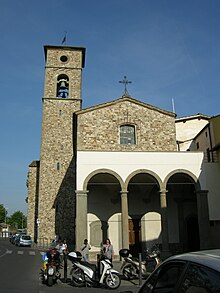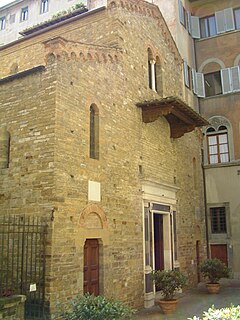
The Church of Santi Apostoli is a Romanesque-style, Roman Catholic church in the historic center of Florence, in the Tuscany region of Italy. It is among the oldest church buildings in Florence.
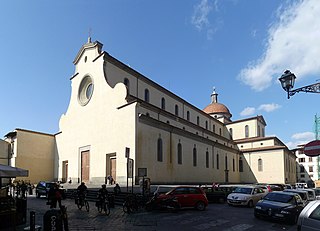
The Basilica di Santo Spirito is a church in Florence, Italy. Usually referred to simply as Santo Spirito, it is located in the Oltrarno quarter, facing the square with the same name. The interior of the building - internal length 97 meters - is one of the preeminent examples of Renaissance architecture.

San Salvatore al Vescovo is a church located in Florence, Italy.
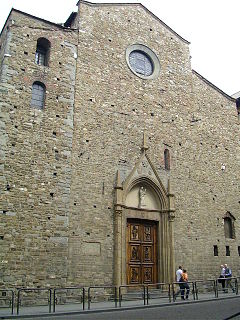
Santa Maria Maggiore di Firenze is a Romanesque and Gothic-style, Roman Catholic church in Florence, region of Tuscany, Italy. This is among the oldest extant churches in Florence.

Santo Stefano al Ponte is a Romanesque-style, Roman Catholic church, located in the Piazza of the same name, just off the Via Por Santa Maria, near the Ponte Vecchio, in Florence, region of Tuscany, Italy. The church is presently used as a concert hall.
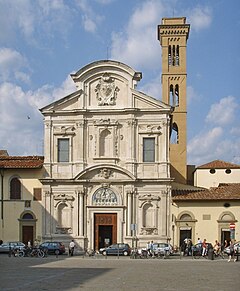
The chiesa di San Salvatore di Ognissanti or more simply chiesa di Ognissanti, is a Franciscan church located on the piazza of the same name in central Florence, region of Tuscany, Italy. Founded by the lay order of the Umiliati, the church was dedicated to all the saints and martyrs, known and unknown.
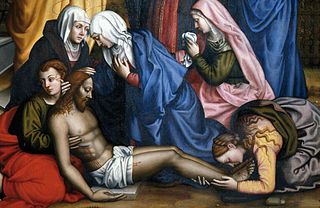
Sister Plautilla Nelli (1524–1588) was a self-taught nun-artist and the first-known female Renaissance painter of Florence, Italy. She was a nun of the Dominican convent of St. Catherine of Siena located in Piazza San Marco, Florence, and was heavily influenced by the teachings of Savonarola and by the artwork of Fra Bartolomeo.

Santa Maria del Carmine is a church of the Carmelite Order, in the Oltrarno district of Florence, in Tuscany, Italy. It is famous as the location of the Brancacci Chapel housing outstanding Renaissance frescoes by Masaccio and Masolino da Panicale, later finished by Filippino Lippi.

Palazzo Spini Ferroni is a large Gothic palace located along Via de' Tornabuoni at the corner of Piazza Santa Trinita, in central Florence, region of Tuscany, Italy. It stands across from the church of Santa Trinita.

Sant'Apollonia was a former Benedictine convent, founded in 1339, just north of the center of Florence, in Italy.
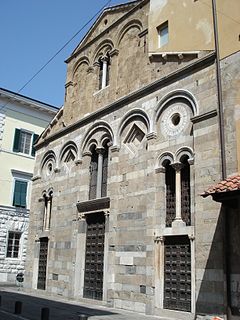
San Pietro in Vinculis is a Romanesque-style, Roman Catholic church in Pisa, region of Tuscany, Italy.

Arezzo Cathedral is a Roman Catholic cathedral in the city of Arezzo in Tuscany, Italy. It is located on the site of a pre-existing Palaeo-Christian church and, perhaps, of the ancient city's acropolis.

The Last Supper (1480) is a fresco depicting the Last Supper of Jesus by the Italian Renaissance artist Domenico Ghirlandaio; it is located in the refectory of the Convent of the Ognissanti on Borgo Ognissanti #42 in central Florence, region of Tuscany, Italy. It is one of three Last Supper frescoes painted by Ghirlandaio in Florence, the others being for the Badia di Passignano (1476) and for the Cenacolo di San Marco (1486).

The Torre dei Gianfigliazzi is a Romanesque-style medieval tower-residence located on Via de' Tornabuoni #1 in central Florence, region of Tuscany, Italy. It can be seen rising adjacent to the left of the church of Santa Trinita. It now hosts a hotel.

The Badia di Passignano, also called the Abbey of San Michele Arcangelo a Passignano is an historic Benedictine abbey located atop a scenic hilltop, surrounded by cypresses, east of the town of Tavarnelle Val di Pesa, Province of Florence, Italy. The abbey complex is located about 2 kilometers east of the Siena-Florence autostrada.
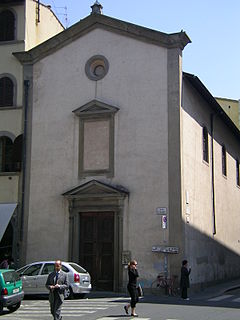
The Oratory of Gesù Pellegrino, also called the Oratorio dei Pretoni, is a Roman Catholic prayer hall or small church found on the corner of Via San Gallo and via degli Arazzieri in Florence, region of Tuscany, Italy.
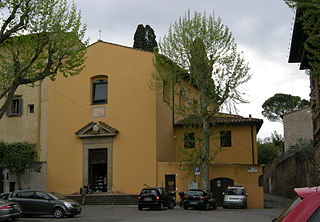
San Francesco di Paola is a small Renaissance-style Roman Catholic church in the Oltrarno quarter of Florence, central Italy.

San Fabiano is a Romanesque-style church and abbey in Prato, Tuscany, central Italy. It is located at Via di Gherardo and Via del Seminario street in Prato. The early medieval church is one of Prato's oldest churches.
The Evangelical Methodist Church of Florence is an Italian Methodist church located on via de' Benci #9 of Florence, region of Tuscany, Italy. The congregation occupies the former Roman Catholic church of San Jacopo tra i Fossi, founded in the 12th century. It was originally staffed by Vallombrosian monks of San Salvi, but by 1543 it was transferred to the Augustinian order that had remained faithful to Cosimo I. The present church was rebuilt in the 17th century. The adjacent convent and church were suppressed in 1808. The church was allocated in 1874 to the Scottish missionary John R. MacDougall. As of 2013, the Methodist Church is currently cared for by the pastor of the Waldensian Church of Florence, and the Tuscany Methodist Circuit.

Santa Maria or Santa Maria a Campi is a Roman Catholic parish church located on Via Spartaco Lavagnini #26 in Campi Bisenzio, just west of Florence, in the region of Tuscany, Italy.
